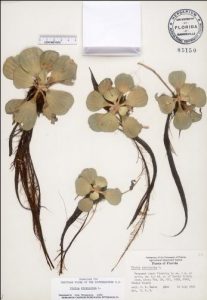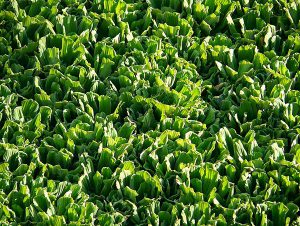
Water lettuce is one of the usual suspects, a common troublemaker, targeted for management on just about every lake and stream in Florida every year. This floating plant reproduces quickly and forms large mats that can block boat ramps, clog canals, and be a serious nuisance. However, managing this plant has become rather contentious in recent years. Some will point to the fact that water lettuce was clearly documented by both John and William Bartram as they surveyed Florida in the 1700s. They explain these references indicate water lettuce is a native plant and should be left to thrive. Next, they point out that water lettuce grew unchecked for hundreds of years and Florida’s natural aquatic ecosystems were healthy and vibrant. Why, then, has this plant been targeted as a public enemy for the past 40 years? If nature managed this plant with little issue for hundreds of years, why not let it do the same now?

Honestly, this is a great question that uses both sound logic and reason. To answer the question, we have to ask ourselves another, equally important, question: what is different now vs 300 years ago? Is water lettuce different? Is it more aggressive, more reproductive, more troublesome than in the past? Science suggests water lettuce has not changed and behaves strikingly similar to how it did centuries ago. The next question is naturally, is Florida different now than it was 300 years ago? I believe that even the casual observer would agree Florida has undergone radical changes in the past 50 years, not to mention the last 300. Simply put, water lettuce may not have changed, but Florida has.
Florida lakes, as a rule, are rather shallow – often with an average depth of 4-6 feet. However, the subtropical climate of Florida brings near 60” of rainfall annually, with 2/3 of this total occurring between June and September. Historically, these summer rains resulted in dramatic increases in water depth, with some lakes documented to raise 5-8 feet in the summer months. This massive fluctuation would flood large areas and force floating plants and muck sediments to be flushed out of the system and stranded on the shore when the water receded in fall/winter. For centuries, it is said that this was how shallow lakes in Florida cleansed themselves of over-grown plants. This routine and dramatic flooding was anticipated by the 34,000[1] residents that called Florida home in the 1830’s (this seems to be the first reliable Census record). There was plenty of land per person and avoiding floodplains was rather easy. However, as the population of Florida steadily grew, avoiding flooding became more difficult.
In 1947, just 19 years after the Okeechobee Hurricane caused massive destruction and loss of life, the Cape Sable Hurricane crossed the state and caused considerable flooding. It is reported that approximately 5,000,000 acres of peninsular Florida was covered with 6 inches to 10 feet of water[2]. This inevitably led to the formation of Flood Control districts in 1949, which ultimately became the Water Management Districts in 1972. As a result, many of our lakes now have water control structures that prevent flooding by reducing these drastic fluctuations in depth. Meanwhile, miles of canals and hundreds of pump stations were installed across the state to move water quickly and efficiently to maintain safe water levels.
So, what does all this have to do with water lettuce? Well, let us return to Bartram[3].
“…pistia, which send down very long fibrous roots deep into the water by which they are nourished, growing all matted together in such a manner as to stop up the mouth of a large creek…”
These tangled roots slow water flow, not to mention the floating plants can lodge against flood structures. Rafts of plants alter the functionality of the structure, or even cause damage if the populations are high enough.

Water lettuce is a proper threat to flood control. In Bartram’s day, with only a few thousand people in Florida, flood prevention was not a pressing issue. But today, with over 21 million residents, flood control is essential for Florida and managing plants like water lettuce is of primary importance.
A second consideration is legislative. Bartram would have never thought plant management laws would become necessary, but today they are a reality. Florida statute, under the Florida Aquatic Weed Control Act[4], now requires the Florida Fish and Wildlife Conservation Commission to:
“…direct the control, eradication, and regulation of noxious aquatic weeds and direct the research and planning related to these activities…so as to protect human health, safety, and recreation and, to the greatest degree practicable, prevent injury to plant and animal life and property.”
Why should water lettuce be controlled when for hundreds of years it was not necessary? The simple answer is that the plants have not changed, but Florida has. Our massive state population requires protection from flooding and simply managing floating plants is a key step toward making this happen.
Dr. Jason Ferrell, UF/IFAS CAIP Director, wrote this piece. For more information about the UF/IFAS Center for Aquatic and Invasive Plants, please visit http://plants.ifas.ufl.edu. Be sure to follow us on social @UFIFASCAIP.
UF/IFAS CAIP, Turning Science Into Solutions.
Sources:
[1]https://web.archive.org/web/20141121134738/http://www.census.gov/population/www/documentation/twps0056/tabs15-65.pdf
[2] https://www.weather.gov/safety/flood-states-fl
[3] Diary of a Journey through the Carolinas, Georgia, and Florida from July 1, 1765, to April 10, 1766. – John Bartram and Francis Harper. P 39. Transactions of the American Philosophical Society, Vol. 33, No. 1 (Dec., 1942).
[4] http://www.flsenate.gov/Laws/Statutes/2011/369.20
 1
1
